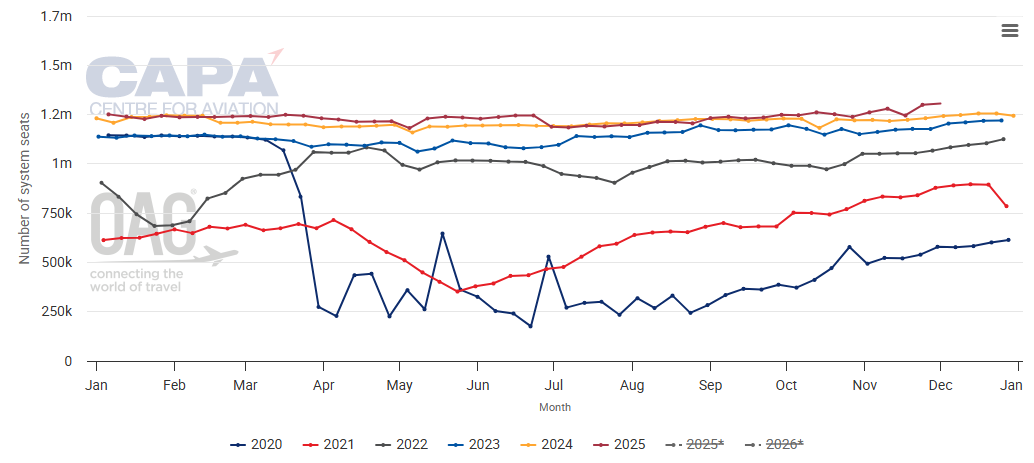Navi Mumbai Airport to open on 25-Dec-2025, Adani Group to extend its investment there

The 'race' (a slow, ponderous one) has been on in India between the two main cities of Delhi, the capital, and Mumbai, the main commercial one, to build a second airport and thus to become the first Indian city to have one.
For now it looks like Mumbai is the winner as its Navi ('new') Mumbai Airport, a public-private partnership, is slated to open on 25-Dec-2025 unless Delhi somehow comes up on the rails and pips it at the post.
While airlines aren't exactly queuing up to operate there (Air India is yet to put in an appearance but Air India Express will do so) at least three airlines including IndiGo, now the largest carrier domestically, will be there from day one.
That speaks well for its prospects and the envisaged development schedule is a rapid one culminating in a 90mppa throughput and, astonishingly 50 million capacity by mid-2029.
That begs the question of which will be the main Mumbai airport in a few years time because the existing airport cannot be expanded at anything like that rate.
Moreover, IATA projects 5.6% average annual growth rate in India over the next twenty years meaning an additional 425 million annual passenger journeys expected by 2044 which would nearly triple 2024 levels while air passenger journeys per 1,000 inhabitants will rise from 148 to 258 trips.
It also sheds light on the contribution of Adani Airports, the main private sector airport operator now, which will manage both airports and which is prepared to shovel even more cash into the sector, focusing on its existing Indian airports.
Summary
- Navi Mumbai International Airport is set to open on 25-Dec-2025, making Mumbai the first Indian city with two airports.
- The airport will initially handle 20 million passengers annually, with plans to expand capacity to 90 million by 2029.
- Adani Airports, the main private sector operator, holds a 74% stake in both Mumbai airports and is investing heavily in expansion.
- Major Indian airlines including IndiGo, Akasa Air, and Air India Express will operate from Navi Mumbai from day one, though Air India has not yet committed.
- The dual-airport system is expected to relieve congestion at the existing Mumbai airport, which has limited expansion potential.
- India’s air travel market is projected to nearly triple by 2044, highlighting the strategic importance of Navi Mumbai’s rapid development.
Navi Mumbai Airport to open on 25-Dec-2025; first major Indian city with two airports
Navi Mumbai International Airport (NMIA), the second airport for India's chief commercial city, will commence operation on 25-Dec-2025. Construction commenced in Oct-2016.
Mumbai will be the first city in India to have more than one airport, unless it is pipped at the post by the Noida airport, the second to service the Delhi capital area, which is scheduled to open approximately at the same time.
The airport is being built and will be operated by Navi Mumbai International Airport Limited (NMIAL), a public-private partnership between the Adani Airports Holdings Limited (74%) and the City and Industrial Development Corporation (CIDCO) (26%).
NMIAL was established as a special-purpose vehicle by the partners to oversee the project's development and construction.
The airport was formally opened by Indian Prime Minister Narendra Modi in Oct-2025.
It occupies an area of 1,160ha in Navi Mumbai, to the east of Mumbai and with an estimated population of 2.6 million in a wider metropolitan area of 26 million.
Navi Mumbai location

Source: Google Maps.
Will be a dual airport system
The airport is designed to operate alongside Mumbai Chhatrapati Shivaji Maharaj International Airport (MCSMIA) under a dual-airport system.
The existing Mumbai airport has two runways, of 2,871m × 45m and 3,190m × 46m although only one is operational typically. In 2024 it handled 54.8 million passengers, making it India's second busiest airport after Delhi Indira Gandhi Airport and over 16% higher than the 2019 pre-pandemic total of 47.1 million.
In fact it exceeded the 2019 total in 2023. But growth so far in 2025 has been only +1.4%, a level typical of 'post-post COVID-19' stagnation in many parts of the world.
Moreover, seat capacity in 2025 has not grown comparable to 2024 possibly in anticipation of the commencement of operations at Navi Mumbai being imminent.
Mumbai Chhatrapati Shivaji Maharaj International Airport weekly total system seats capacity

Source: CAPA - Centre for Aviation and OAG.
Initial capacity of 20mppa will rise to 90mppa
Navi Mumbai will initially handle 20 million passengers annually and will expand to a capacity of 90 million passengers once fully operational.
Planned expansion includes four runways, multiple terminals, and dedicated facilities for handling perishables and express cargo. Initial cargo capacity will be 0.5 million metric tonnes per annum.
From 25-Dec-2025 to 31-Jan-2026, the airport will operate between 08:00 and 20:00, handling 23 scheduled daily departures and up to 10 aircraft movements per hour. During this period, the airport will be served by IndiGo, Akasa Air and Air India Express, operating services connecting Navi Mumbai to 16 domestic destinations.
So far Air India has not announced its intention to operate there.
IndiGo stakes its claim early but only for domestic services
IndiGo, which is the largest carrier at MCSMIA in terms of both capacity and movements will operate the inaugural service at Navi Mumbai, arriving from Bengaluru, home to India's third busiest airport and also an important city commercially.
There will be approximately 120 air traffic movements (ATMs) daily in the initial phase.
The first arrival and departure flights will be operated by IndiGo, followed by Air India Express and Akasa Air.
Starting Feb-2026, the airport will transition to round-the-clock operations, expanding to 34 daily departures to meet the increasing needs of the area.
To ensure a seamless start, NMIA is conducting comprehensive Operational Readiness and Airport Transfer (ORAT) trials in collaboration with all stakeholders, including security agencies and airline partners. Further strengthening its preparedness, the Central Industrial Security Force (CISF) was formally inducted at NMIA on 29-Oct-2025, with deployment across key airport functions.
IndiGo intends to connect Navi Mumbai to 10 domestic destinations from launch, including Delhi, Bengaluru and Hyderabad, with further expansion expected.
IndiGo has extensive international services from both the existing Delhi and Mumbai airports - its total flight inventory is greater than that of Air India - and has been increasing them recently. However, there are no indications at present that it will start international flights from NMIA.
Akasa Air also scheduled inaugural services from 25-Dec-2025, linking Navi Mumbai to cities such as Goa, Delhi and Kochi, and outlined ambitions to ramp up to 300 domestic and 50 international weekly departures by FY2027. Air India Express announced 20 daily services to 15 domestic destinations initially.
Adani Group growing quickly; has a hand in both Mumbai airports
The Adani Group has made great strides since entering the airport sector in 2015 to become the largest operator there after Airports Authority of India, and the largest private sector one.
Apart from its share in the development of NMIA it also has a 74% stake in MCSMIA where Airports Authority of India holds 26%; it also holds equity in seven other Indian airports as identified on the map below (Navi Mumbai is not identified until it formally opens) and is poised to extend that ownership position when the next tranche of airport concessions take place, a procedure that has been delayed for several years.
Active airports for Adani Group, Adani Airports

Source: CAPA - Centre for Aviation.
Attempts at foreign investment not yet fulfilled...
Adani has also attempted to be active internationally.
In 2024 Vietnam's Government let it be known that Adani Group planned to invest in the construction of Long Thanh International Airport and Chu Lai International Airport as part of a USD10 billion cross-sector package. However both remain at the consideration stage.
More significantly perhaps, Adani initially got the green light from the Kenyan government over the construction of a new terminal and second runway at Nairobi Jomo Kenyatta International Airport, in addition to renovation of existing facilities.
However, late in 2024 the government terminated the proposed investment after it was opposed by strike action from the Kenya Aviation Workers Union and then the High Court blocked the concession agreement altogether.
…so funds retargeted at core Indian investments, including Navi Mumbai
Adani subsequently re-targeted its investment funds towards the expansion of NMIA with a potential investment of USD3.4 billion in the third phase to expand the capacity, primarily for the new airport's second terminal, which is planned to open in 2029, a second runway, automated people movers and metro connectivity.
The new investment is a combination of equity and debt. The project is a long-term public-private partnership (PPP), in which the Maharashtra government holds 26%.
The goal of the investment is to increase the airport's annual passenger capacity from 20 million to 50 million by mid-2029; a very rapid increase by any standards.
This follows an initial investment of about USD2.2 billion for the first two phases (Terminal 1 and a runway) which culminate in the 25-Dec-2025 opening.
Construction for this next expansion phase is expected to begin within six to nine months.
In the interim the cargo terminal is expected to become operational in 2026.
Adani seeks to raise a further USD3 billion by 2027
To help finance all this Adani Airport Holdings aims to raise USD3 billion to fund capital spending by 2027. It has already raised (Jun-2025) USD1 billion in project financing for Mumbai International Airport Ltd, the operator of MCSMIA.
That financing includes USD750 million in investment-grade bonds maturing in Jul-2029, with an additional USD250 million provisioned under the same framework. Major international investors, including Apollo-managed funds, BlackRock, and Standard Chartered, backed the deal.
Which will be the primary airport in 10 years time?
The burning question is how the very rapid expansion of NMIA will impact on MCSMIA. In 10 years time which will be Mumbai's main airport? Or even five years?
It was understood from the start that NMIA would act as a secondary gateway and hub to decongest the Chhatrapati Shivaji Maharaj International Airport.
Currently, and as mentioned earlier, Mumbai's main airport operates most of the time with a single crossing runway and two terminals, limiting its further expansion potential despite an ongoing terminal (T1) redevelopment scheme and the fact that Adani Group already has access to a large fund the proceeds of which could be diverted to its existing airports, which is something it said it intended to do back in 2024.
So the new facility should balance passenger loads and support future traffic growth.
In only a handful of years NMIA will be able to host 90mppa and is suitably located to attract airlines, passengers and cargo
But upon completion, NMIA will transform into a mega aviation hub, supporting 90 million passengers annually and integrating city-side infrastructure like hotels, offices, and retail, with Adani targeting 70% non-aeronautical revenue by 2030.
The airport's strategic location and phased expansion align with India's goal to become the world's third-largest aviation market by 2030, fostering economic growth and job creation in the Mumbai Metropolitan Region, India's shining commercial star.
If the (long delayed) opening procedure, the first few months of operation and the shift into Phase 3 go well then it is quite conceivable that NMIA will become the Mumbai airport to receive most attention and progress to a point where it becomes the city's premier gateway.
READ MORE from the CAPA - Centre for Aviation archive
Recent CAPA - Centre for Aviation analysis reports on Adani Airports and Mumbai airports.
APR-2025: Indian airlines welcome development of dual-airport systems in Mumbai and Delhi.
AUG-2024: Adani Airports zeroes in on first foreign investment but Nairobi deal is far from certain.
APR-2024: India's Adani Airports to invest USD7 billion in airport expansion as Indian aviation explodes.
FEB-2024: 'State of the art' Navi Mumbai Airport 60% completed, and scheduled to open end Mar-2025.


